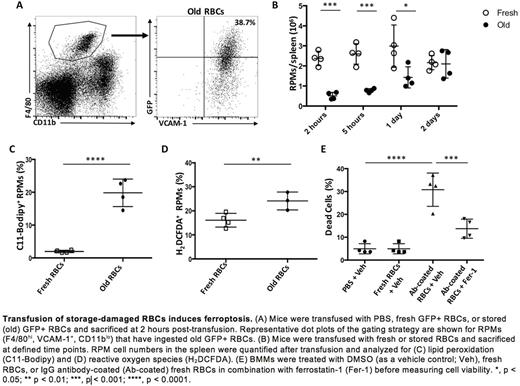Abstract
Red blood cell (RBC) transfusions are a common therapeutic, used in a wide range of settings (e.g., trauma). Therefore, potential outcomes, positive or negative, have special clinical relevance. Preparation of RBC units for transfusion involves refrigerated storage for an extended period of time, during which RBCs undergo multiple metabolic and physical changes, collectively known as the "storage lesion." As a result, a proportion of the stored RBCs are rapidly cleared from the circulation post-transfusion by macrophages in the liver and spleen. However, the subsequent effects on macrophages of an acute, robust erythrophagocytosis event are still unclear, especially given the substantial amount of iron that is introduced into the cell in a short amount of time. Therefore, we sought to study the effects of substantial erythrophagocytosis on splenic macrophages, which normally play a key role in RBC-derived iron recycling. One possible outcome is macrophage cell death due to ferroptosis, an iron-dependent form of non-apoptotic cell death originally identified in cancer cells, but not yet demonstrated in macrophages.
Using a mouse model of storage-damaged RBC transfusion and clearance, wild-type C57BL/6 mice were transfused with fresh (i.e., <24 hr after collection) or 12-14-day stored RBCs, and splenocytes were analyzed at defined time points post-transfusion. By 2 hours post-transfusion, a significant portion of splenic red pulp macrophages (RPMs; VCAM-1+, F4/80hi, CD11blo) had ingested stored RBCs (38.2%; p < 0.0001; Figure A), but not fresh RBCs (2.1%; p < 0.05). Other phagocytes, such as Ly6C+ monocytes (Ly6Chi, CD11b+, CD115+, Ly6G-) and granulocytes (Ly6G+, Ly6Chi, CD11b+) cleared far fewer RBCs: 7.02% (p < 0.0001) and 0.66% respectively. By 2 hours post-transfusion, the number of RPMs dramatically decreased (from 2.4 x 106 to 0.5 x 106 cells per spleen; p < 0.001; Figure B), before returning to steady-state levels by 2 days post-transfusion; thus, transfusion of stored RBCs markedly depletes the available macrophage population in the spleen. Nonetheless, Ki67 staining revealed that RPMs in mice transfused with stored RBCs substantially increased their cell division by 1 day post-transfusion (5.8% to 14.8%; p < 0.01), indicating that these tissue resident cells can self-regenerate locally after transfusion-mediated depletion.
Further studies into the mechanism of RPM cell death uncovered ferroptosis-specific characteristics. Thus, by 2 hours after transfusion of old RBCs, increased levels of DCF fluorescence, indicative of reactive oxygen species (16.1% to 24.1%; p < 0.01; Figure C) and C11-Bodipy fluorescence, indicative of lipid peroxidation (2.0% to 19.8%; p < 0.0001; Figure D) were seen. In addition, qPCR analysis of RPMs revealed a 7.9-fold increased expression of PTGS2, which encodes COX-2 (p < 0.001); PTGS2 mRNA is reported to be induced in cells undergoing ferroptosis, downstream of lipid peroxidation. Using bone-marrow-derived macrophages (BMMs) exhibiting a uniform population of F4/80hi and VCAM-1+ cells, which are characteristic of RPMs, we demonstrated that ferrostatin-1 (a ferroptosis inhibitor; 100 µM) rescued cell death in BMMs that had ingested antibody-coated RBCs (30.8% to 13.7%, p < 0.0001; Figure E). Furthermore, ferrostatin-1 decreased the levels of reactive oxygen species (61.4% to 12.6%, p < 0.0001) and lipid peroxides (25.7% to 13.6%; p < 0.001) in BMMs that had ingested RBCs, without decreasing the overall proportion of BMMs that ingested RBCs. In addition, BMMs and J774.1 cells (a murine macrophage cell line) were sensitive to erastin (25% cell death; 1 µM, p < 0.0001), which induces ferroptosis in numerous cancer cell lines.
In conclusion, substantial erythrophagocytosis after transfusion of storage-damaged RBCs induces ferroptosis in splenic RPMs. To date, ferroptosis has been described in cancer cells, kidney tubule cells, fibroblasts, neurons, and T cells. However, to our knowledge, this is the first report in macrophages, which play important roles in RBC clearance and iron recycling. This finding sheds light on potential adverse effects on macrophage populations from transfusions of "old" RBCs and also highlights a potential clinical use for ferroptosis inhibitors for preventing substantial losses in an important phagocyte population.
Spitalnik: New Health Sciences: Consultancy, Membership on an entity's Board of Directors or advisory committees.
Author notes
Asterisk with author names denotes non-ASH members.


This feature is available to Subscribers Only
Sign In or Create an Account Close Modal